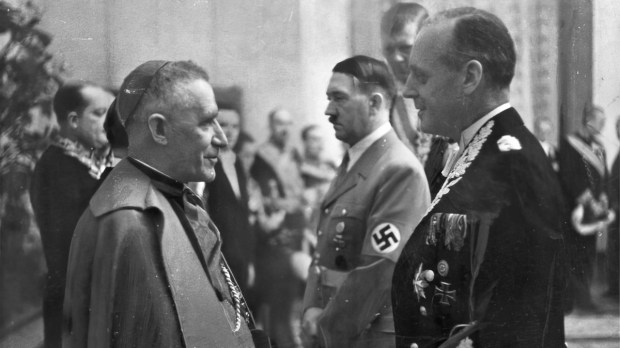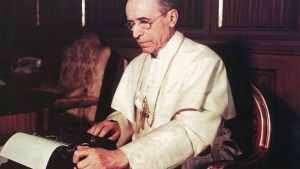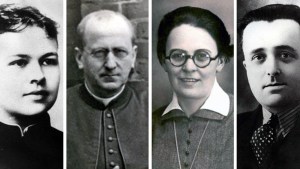The Pontifical Gregorian University hosted an international conference on “New documents from the pontificate of Pope Pius XII and their meaning for Jewish-Christian relations: a dialogue between historians and theologians.” During the event (October 9-11), several presentations showed how the Vatican archives were also an important source of information on Church action throughout Europe. In particular, they showed that Catholic solidarity with Jews during the Second World War varied according to each country and its circumstances. (See also our article specifically on Pius XII.)
Antisemitism in Poland
For example, historian Monika Stlolrarczyk-Bilardie showed that the reports sent to Rome by Poland’s bishops focused on the atrocities committed by the Germans and Soviets against Polish Catholics. In these reports, Jews were sometimes the subject of judgments marked by anti-Semitism. “No one denies the grave faults of the Jews against Poland and the Church. Their present sad condition is nothing more than the application of the Law of Talion,” reports a 1942 note recounting the words of Cardinal Adam Sapieha, archbishop of Krakow.
Italy, where bishops and a bicyclist saved Jews
In Italy, on the other hand, dynamic networks of assistance to Jews were encouraged by the bishops, with the support of the Pope. This was notably the case in Verona, Genoa, Florence and Turin. Belgian historian Johan Ickx, in charge of the archives of the Secretariat of State, highlighted in particular the commitment of the bishop of Assisi, a town with no Jewish community. He recalled that the bishops of Florence and Assisi relied in particular on the champion cyclist Gino Bartali, who commuted by bicycle between the two Italian cities to smuggle documents.
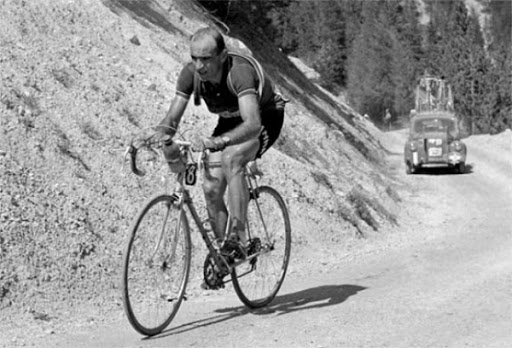
In 1939, Italy was home to some 39,000 Jews, according to historian Liliana Pinciotto. Some 81% of them were saved, 16% of them by the Church. According to her work, 7,000 Jews were deported, 4,300 Jews fled to Switzerland and just over 27,000 Jews remained in the country and survived the persecution. In all, the historian has recorded 6,000 cases of rescue.
Liliana Pinciotto was keen to point out that, in addition to Jews, the Church often took in escaped prisoners, deserters, and political opponents who risked their lives under the Fascist and then Nazi regimes. She also justified certain refusals to house Jews in Rome by recalling the overpopulation of the capital during the war, which grew from 800,000 to 1.5 million inhabitants.
The troubled role of the nuncio in France
As for France, Nina Valbousquet, historian at the École française of Rome, spoke about the documents of Archbishop Valerio Valeri, nuncio to France between 1936 and 1944. He was considered very close to Vichy. Recalling the denunciations of the bishops of Toulouse, Montauban and Lyon, the historian felt that the actions of the local Church in France were more important than those of the nuncio in the light of the new documents.
In a letter written in 1942, the nuncio, who had often opposed actions in favor of the Jews, nevertheless welcomed the decision of the archbishop of Toulouse to give refuge to Jewish children in a Catholic school. But he asks him to ensure that his guests do not “harm their classmates from a religious point of view.” Filled with prejudice against Jews, Archbishop Valeri, who would be created a cardinal by Pius XII after the war, “gave priority to defending the Church,” defending a “narrow conception of the Church’s mission” that the bishops, who denounced his stance, would not follow, said Nina Valbousquet.
Informed by its nuncios, “the Vatican machine seems to have had difficulty understanding the concrete challenge that the ruthless reality of those years posed to the traditional practice of papal diplomacy,” noted Vatican archivist Giovanni Coco.
The complex issue of South American exfiltration
American historian Gerald Steinacher, professor at the University of Nebraska, presented his research on the exfiltration of Axis criminals through the aid given to refugees by the Pontifical Assistance Commission created by Pius XII in 1945. The Pope had rejected the principle of “collective German responsibility” and considered that the “satanic specter” of Nazism was the responsibility of only a few high-ranking officials.
Consequently, he mobilized the diplomacy of the Holy See to avoid death sentences. Some documents even mention the fear, on the part of Holy See diplomats, of “Jewish vengeance,” which would have raised the risk of a new cycle of violence in Europe.
In particular, the American historian identified the Holy See’s involvement in the exfiltration of 8,000 Ukrainians, former members of the Waffen SS Galicia division. The rector of the Teutonic College, Bishop Alois Hudal, was directly involved in the exfiltration of Nazi criminals. The case of Erich Priebke (1913-2013) particularly shocked Italian public opinion: The man responsible for the 1944 massacre of the Ardeatine Pits in Rome was baptized Catholic by a priest who then provided him with false papers for his exfiltration to Argentina.
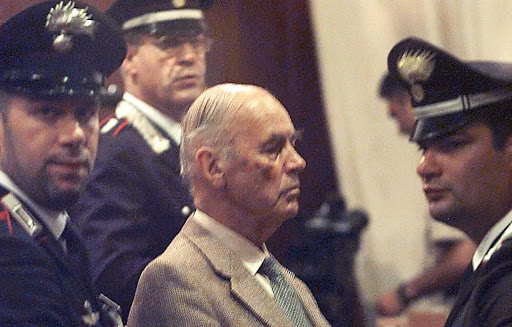
Vatican requests for leniency
The Holy See also asked the Allies for clemency for Franz Von Papen, who as Vice-Chancellor had signed the Concordat with Cardinal Pacelli in 1933, and for Ernst von Weizsäcker, who took refuge in the Vatican from 1945 to 1946, having been German ambassador to the Holy See from 1943 to 1945. The latter was subsequently tried and convicted by Allied justice for “crimes against peace.”
But the Holy See issued letters in his defense, explaining that the German ambassador, in the context of the war and under pressure from Hitler’s entourage, had respected and ultimately protected the neutrality of the Holy See and religious institutions. His son Richard von Weizsäcker, who also acted as his lawyer during his trial, became President of the Federal Republic of Germany from 1978 to 1984.
Church support for German reconstruction
The conversion to Catholicism of certain high-ranking Nazi officials, such as the former Governor General of Poland Hans Frank, before his execution at Nuremberg in 1946, was also part of an existential crisis for German identity, explained Gerald Steinacher. The German state no longer existed between 1945 and 1949, and the Catholic Church was the only major institution capable of ensuring a certain continuity of public services: During this period, it often played the role of “interim state” to prevent German society from collapsing.
The Holy See’s representative in Germany, Archbishop Muench, originally from the United States, worked to rehabilitate German state officials. He did this in close collaboration with the American occupying forces, by whom he was also employed as a liaison consultant to the military administration.
The Holy See’s position at the time was thus set against the backdrop of the onset of the Cold War, an issue to which Pius XII was very attentive. Faced with the existential danger posed by the USSR and communism, there was an urgent need to put Western states and their administrations back into service, without going too far in the purge or in the “vendetta.” It wasn’t until several decades later that questions of memory, particularly the memory of the Holocaust, would take center stage on the international agenda.
